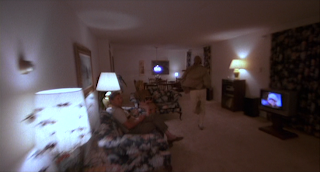It has been three long years since the Coen brothers have released a motion picture, a gap of inactivity as long as any in their thirty year career. Thankfully that will all end this December with the arrival of their sixteenth feature, Inside Llewyn Davis. Inspired by a recent conversation on Letterboxd, I have decided to spend the fall working my way chronologically through all of the Coens' feature films and maybe writing something up here on the old whatchamcallit if the mood strikes me.
A man and woman long for a child but when they discover that they are incapable of producing offspring, they resort to the man's preferred form of transaction, theft.
Nowhere is the Coen brothers' unparalleled wielding of the English language more apparent than in the breakneck ten-minute prologue that opens their 1987 comedy, Raising Arizona. The opening section tells us of how a small town police officer named Edwina falls for H.I., a two-bit convict who has an infectious tendency to wax poetical. Describing Ed's former lover, H.I. narrates, "He ran off with a cosmetologist who knew how to ply her feminine wiles." Later, upon discovering Ed's infertility that kicks off the plot, he says, "Her insides were a rocky place where my seed could find no purchase." This is what distinguishes the work of the Coens from their contemporaries. That and the invention of a dirty, motorcycle-riding nightmare named Leonard Smalls, a.k.a. The Lone Rider of the Apocalypse. You're not getting that in Splash.
Another film from 1987, Oliver Stone's Wall Street, is often cited as the movie that best took the excess of the Reagan years to task. But to its detriment that film didn't have Nicolas Cage running through a grocery store with a bag of Huggies and a coterie of trigger happy vigilantes on his tail. For my money there is no film that better portrays the hollowness of middle class suburban ideals than Raising Arizona.
Take that chase scene that highlights the middle section of the film. Earlier the Coens take the time to show Cage's former convict H.I. suiting up into the quintessential uniform of the middle class male: slacks, a polo shirt, and some white loafers. He sports the ensemble as he tries to fit in with the family his wife Ed aspires to be but he just can't get on their wavelength. (I blame the Polish jokes, but to be fair, my last name is Strenski.) After he decks his boss for suggesting they spice up their vacuous lives with a wife swap, H.I. returns to his life of crime by robbing a convenience store. At this point he is both trying to assert himself as different from his racist, sexist, entitled boss while also trying to attain the same necessities, namely name brand disposable diapers. The brand actually is a sign of importance as we see once the chase moves from the convenience store to a supermarket. H.I. is running through the aisles, being pursued by all manner of threat: cops, dogs, and shoppers. He bolts down the diaper aisle and carefully peruses the names before selecting Huggies, the same brand he lifted earlier.
The chase also includes an exhilarating run through a multi-story pre-fabricated suburban home. H.I. bursts through the front door and runs rampant through bedrooms, dens, and living rooms. The occupants of the household, who are only glimpsed for mere moments, never once overtly react to the pursuit taking place in their abode. The father sits on the couch across from the television and just casually looks up. The great thing about these moments is that the Coens are smart enough not to draw attention to these peripheral asides. They exist on the edges of the frame, never once is there a close up or reaction shot from the family.
This chase is the scene most often referred to when discussing Raising Arizona and it admittedly is a bravura, high-concept high wire act. But there is another action scene in the film that equals the grocery chase in terms of filmmaking and narrative construction. This scene is the finale which sees H.I. and Ed trying to take the baby Nathan, Jr. back from the clutches of The Lone Biker of the Apocalypse. The Coens pull out all of the stops here with an action scene that probably cost more to film than all of Blood Simple combined. The Lone Biker of the Apocalypse appears in a mushroom cloud explosion on the horizon and proceeds to ride into the frame, shooting out both the front and rear windows of the couple's car. He then rides by and throws a grenade inside. The Coens then show both characters fleeing for their lives.
The heart of the film is Ed, particularly the hurt and longing exhibited by the great Holly Hunter. After escaping the now obliterated vehicle she grabs Nathan, Jr. and runs into a bank for safety, a mom protecting her kin, even if she stole the child in the first place. H.I. then gets into a brutal bout of fisticuffs with The Lone Biker of the Apocalypse which also ends in an explosion, with H.I. literally destroying the demons that have plagued him since the kidnapping. From here on out, this career convict will do the right thing and we believe it.









No comments:
Post a Comment